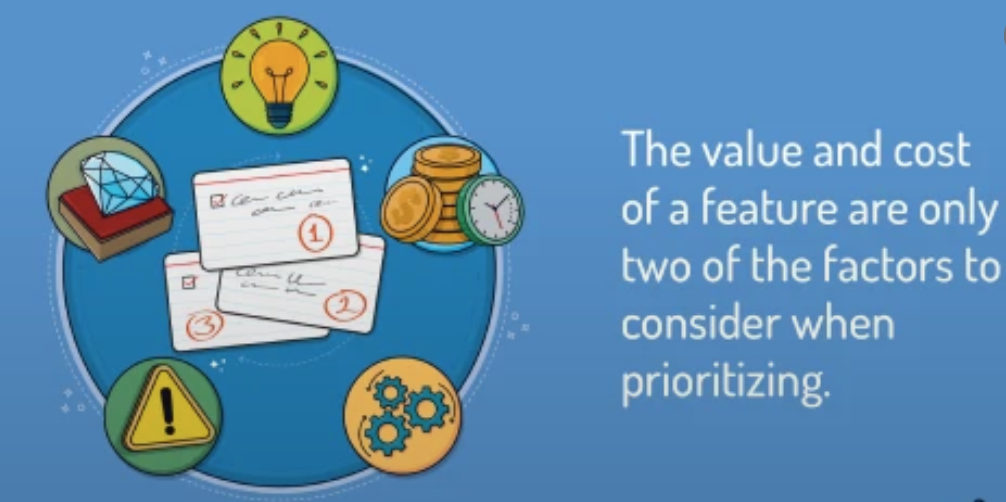The Product Backlog is a critical component of the Scrum Enterprise Model (SEM), encompassing all known functionalities intended for future inclusion in the product and serving as a key enabler for enterprise-level application. Whether backlog items are captured as user stories, job stories, or simple brief descriptions, prioritizing these items effectively ensures that teams continuously deliver the highest-value features. Building the right functionalities in the correct sequence is equally important. Here are five key factors to consider when prioritizing items in the Product Backlog:

Factor 1: Value Let’s start with the most essential factor: value. Although “value” is a commonly understood term, it can be somewhat vague. Value represents the usefulness or impact a particular feature or task offers to its intended audience. Most work pursued by agile teams provides value to users. However, some tasks might primarily benefit the development team, while others could simultaneously benefit users, stakeholders, and team members. Consider refactoring—improving the code structure without altering functionality. Refactoring is highly valuable to developers, making code easier to maintain or modify. Yet, it also indirectly benefits users by reducing bugs and enabling quicker deployment of new features. When assessing the value of a feature, it’s crucial to consider how that value might evolve over time. A feature might be highly valuable today but significantly less so later. For example, consider features for fantasy sports league software—features essential for draft day become nearly worthless if delayed past that critical date.
Factor 2: Cost The second factor in prioritization is cost, primarily measured as the amount of work required by the team. Agile teams typically estimate this effort using story points, person-days, or ideal hours. Occasionally, additional ongoing costs, such as expenses for AI-based functionalities that incur per-use fees, must also be considered. Regardless of the estimation method, the development and support costs of backlog items directly influence their prioritization. For instance, if all other factors are equal, an item estimated at 5 story points should usually rank higher than one estimated at 20 story points.
Factor 3: Learning The third factor is the potential learning value derived from completing a backlog item. Early execution of items that yield valuable insights is beneficial, as it allows the team to leverage that knowledge promptly. Delaying such learnings limits their usefulness. Learning can occur in two areas:
Product Knowledge: By implementing features and obtaining user feedback, the team gains valuable insights into user preferences and behaviors. This knowledge can guide future feature development or help decide which features to eliminate.
Project Knowledge: This involves learning about the project execution itself, such as adopting new technologies or methodologies. For instance, implementing a backlog item using an unfamiliar technology can clarify:
- If the technology works as intended.
- Whether estimations require adjustment.
- Potential wider application across the project.
Factor 4: Risk Risk is the fourth critical factor in prioritization. If an item has inherent risk but must be completed, prioritize it early to identify and address potential issues promptly. Conversely, if a risky item might ultimately be unnecessary, delay it until the requirement is certain.
Factor 5: Dependencies Lastly, consider dependencies between backlog items. Some lower-priority items are essential prerequisites for delivering high-priority items. Therefore, these lower-priority yet foundational tasks should be prioritized earlier to ensure timely completion.
For example, a summer camp using Scrum prioritized repainting canoes highly for marketing purposes. However, repainting depended on repairing and sanding the canoes first, elevating the repair tasks’ priority due to marketing timelines.
Formal Prioritization Techniques: While formal prioritization methods such as the Kano Model, RICE scoring, or Weighted Shortest Job First (WSJF) can offer additional structure, the above five factors should still guide prioritization decisions. Initially prioritize by value and cost, then refine using learning, risk, and dependency considerations.
In summary, the Product Owner in agile and Scrum teams is responsible for prioritizing the Product Backlog. Even without formal methods, simply considering these five factors—starting with enterprise-level perspectives through SEM—is sufficient to effectively prioritize backlog items, ensuring optimal product development outcomes.